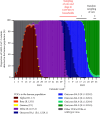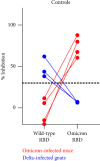Dogs and Cats Are Less Susceptible to the Omicron Variant of Concern of SARS-CoV-2: A Field Study in Germany, 2021/2022
- PMID: 40303725
- PMCID: PMC12017219
- DOI: 10.1155/2023/1868732
Dogs and Cats Are Less Susceptible to the Omicron Variant of Concern of SARS-CoV-2: A Field Study in Germany, 2021/2022
Abstract
Severe acute respiratory syndrome coronavirus 2 (SARS-CoV-2) caused a pandemic of unprecedented extent. Besides humans, a number of animal species can be infected; however, in some species, differing susceptibilities were observed depending on the virus variant. Here, we serologically investigated cats and dogs living in households with human COVID-19 patients. The study was conducted during the transition period from delta as the dominating variant of concern (VOC) to omicron (BA.1/BA.2) to investigate the frequency of virus transmission of both VOCs from infected owners to their pets. The animal sera were tested by surrogate virus neutralization tests (sVNT) using either the original receptor-binding domain (RBD), enabling the detection of antibodies against the delta variant, or an omicron-specific RBD. Of the 290 canine samples, 20 tested positive by sVNT, but there were marked differences between the sampling time and, related thereto, the virus variants the dogs had contact to. While in November 2021, infected owners led to 50% seropositive dogs (18/36), only 0.8% (2/254) of animals with household contacts to SARS-CoV-2 between December 2021 and April 2022 tested positive. In all cases, the positive reaction was recorded against the original RBD. For cats, a similar pattern was seen, as in November 2021, 38.1% (16/42) tested positive, and between December 2021 and March 2022, only 5.0% (10/199). The markedly reduced ratio of seropositive animals during the period of omicron circulation suggests a considerably lower susceptibility of dogs and cats to this VOC. To examine the effect of further omicron subvariants, sera taken in the second and third quarter of 2022 from randomly selected cats were investigated. 2.3% (11/372) tested seropositive, and all of them showed a stronger reaction against the original RBD, further supporting the assumption of a lower susceptibility of companion animals to the omicron VOC.
Copyright © 2023 Constantin Klein et al.
Conflict of interest statement
The authors declare that there are no conflicts of interest.
Figures





Similar articles
-
Nationwide seroprevalence of SARS-CoV-2 Delta variant and five Omicron sublineages in companion cats and dogs in the USA: insights into their role in COVID-19 epidemiology.Emerg Microbes Infect. 2025 Dec;14(1):2437246. doi: 10.1080/22221751.2024.2437246. Epub 2024 Dec 11. Emerg Microbes Infect. 2025. PMID: 39635731 Free PMC article.
-
Serological Evidence of SARS-CoV-2 Exposure in Domestic Dogs and Cats, Thailand: Detection of SARS-CoV-2 Omicron Variant in Dogs Living in COVID-19-Positive Households.Transbound Emerg Dis. 2024 Feb 20;2024:9938523. doi: 10.1155/2024/9938523. eCollection 2024. Transbound Emerg Dis. 2024. PMID: 40303161 Free PMC article.
-
SARS-CoV-2 Infection in Dogs and Cats from Southern Germany and Northern Italy during the First Wave of the COVID-19 Pandemic.Viruses. 2021 Jul 26;13(8):1453. doi: 10.3390/v13081453. Viruses. 2021. PMID: 34452319 Free PMC article.
-
[SARS-CoV-2 infections in cats, dogs, and other animal species: Findings on infection and data from Switzerland].Schweiz Arch Tierheilkd. 2021 Dec;163(12):821-835. doi: 10.17236/sat00329. Schweiz Arch Tierheilkd. 2021. PMID: 34881715 Review. German.
-
Assessment of the Risk Impact of SARS-CoV-2 Infection Prevalence between Cats and Dogs in America and Europe: A Systematic Review and Meta-Analysis.Pathogens. 2024 Apr 12;13(4):314. doi: 10.3390/pathogens13040314. Pathogens. 2024. PMID: 38668269 Free PMC article.
Cited by
-
Household clusters of SARS-CoV-2 Omicron subvariants contemporaneously sequenced from dogs and their owners.mSphere. 2025 Jul 29;10(7):e0007425. doi: 10.1128/msphere.00074-25. Epub 2025 Jul 2. mSphere. 2025. PMID: 40600703 Free PMC article.
-
Longitudinal study on SARS-CoV-2 antibody responses in companion animals, Chile.Vet Q. 2025 Dec;45(1):1-12. doi: 10.1080/01652176.2025.2509504. Epub 2025 Jun 4. Vet Q. 2025. PMID: 40465510 Free PMC article.
References
-
- WHO. Covid-19 strategy update- 14 april 2020. 2020. https://www.who.int/publications-detail/covid-19-strategy-update---14-ap... .
-
- WHO. Tracking sars-cov-2 variants. 2022b. https://www.who.int/activities/tracking-SARS-CoV-2-variants .
-
- WHO. Coronavirus disease (covid-19): variants of sars-cov-2. 2022a. https://www.who.int/emergencies/diseases/novel-coronavirus-2019/question... .
MeSH terms
Substances
Supplementary concepts
LinkOut - more resources
Full Text Sources
Medical
Miscellaneous

